1930s fashion was an era of feminine and romantic style as influenced by America’s captivation with the silver screen and the beautiful stars who wore sensual silks, luxurious lace and backless bias cut gowns. We can thank Rita Hayworth, Greta Garbo, Marlene Dietrich, Jean Harlow and other leading ladies for their influences on 1930s fashion trends, as it was their silver screen star power that inspired the contemporary ’30s lady to pursue a form of “escapism” style based on glitz, glamour and provocative mystery.
Unlike ’20s clothing trends, the ’30s silhouette embraced the female form for all to see. Bias cut slip dresses and natural waistlines replaced drop waist dresses, backless gowns replaced the mini dress trend, and voluminous adornment a la cap sleeves, ruffles and maxi lengths replaced the straight, frill-less lines of a flapper dress meant for comfortable shimmying about the dance floor.
Considering the average income of an American family decreased by 40 percent between 1929 and 1932, you’d think that the styles of the day would be drab, depressing and definitely not as delightful as what you’re about to see in this article! The reality is that because times were so hard, men and women yearned to live vicariously through the fantastical fashions in the theater and attempt to re-create for themselves using sewing patterns and other do-it-yourself methods of clothing production.
While not every American girl was wearing the famous designers of the day a la a Coco Chanel knit suit, an Elsa Schiaparelli hat, a Madeleine Vionnet bias cut dress or a Madame Gres Grecian-style pleated dress, these were still the styles that graced the pages of Vogue and the runways of Paris and which inspired a trickle down effect influencing trends worn by the masses. When not channeling Bette Davis’ Hollywood style, the contemporary ’30s girl was wearing a crepe-silk dress with a pair of laced oxford shoes and an attention grabbing hat perfectly tilted on her head.
Thanks to the female liberation of the ’20s flapper movement, middle class to upscale ladies of the 1930s were more active participants in day-by-day household affairs and were even working part time outside of the home. Thus, nine-to-five fashions were more utilitarian toward comfort and ease of movement.
SHOP NOW: Amazing and authentic 1930s vintage clothing on eBay!
’30s fashion is a vintage style I personally feel is least celebrated in fashion. Perhaps it’s because we mistakenly believe that the Great Depression halted the trends altogether, but in fact the economic strife of the times inspired an entirely new way of designing, wearing and embracing the female form.
1930s Fashion Trends
Feel free to scroll through the post to see all of the 1930s fashion trends, or click any of the links below to be taken immediately to the text within the article.
1930s Fashion Trend #1: Low Back Dresses
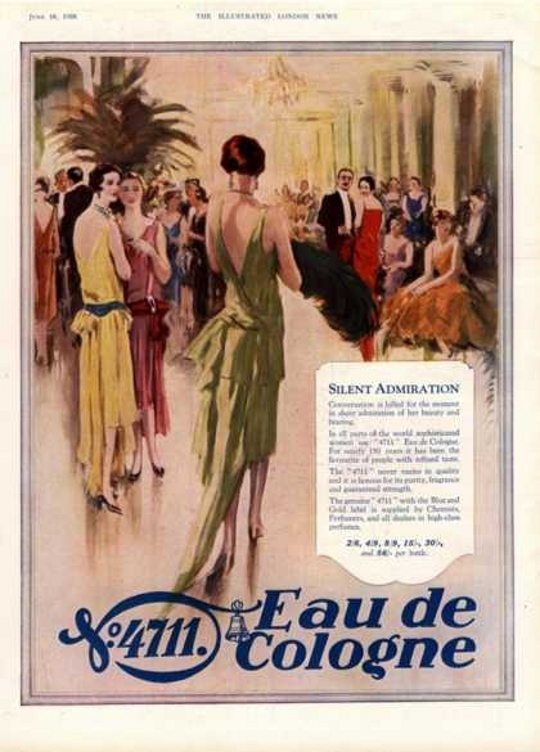
Source: Vintage Ad Browser
Showing off a girls’ back became quite the trend in the ’30s because tanning became trendy for the first time. Previously, if a girl had a tan it meant that she was working outside and was therefore of a lower social status, since only the lower classes were forced to spend their days outdoors. But when sunning gained steam in the ’30s, the glow of one’s skin took on whole new sexy meaning and designers began dipping a lady’s backside to reveal more than just her shoulder blades.
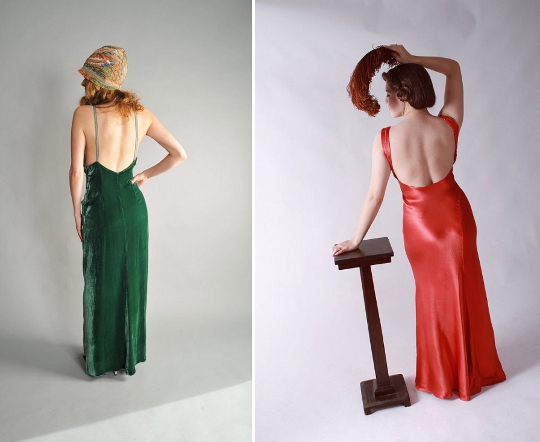
Buy It Vintage: 1930s Emerald Velvet Low Back Dress, $168 / 1930s “Harlow” Glam Low Back Gown, $385
Why It’s Fabulous: Because without having to show too much skin, you can wear a low back velvet or silk dress and know that while you are walking away, everyone is staring at you from behind! You’ll feel the eyes of admirers burn onto your exposed back. Just be sure to wear sun tan lotion before getting the perfect glow for your backless ’30s style!
1930s Fashion Trend #2: Ruffles
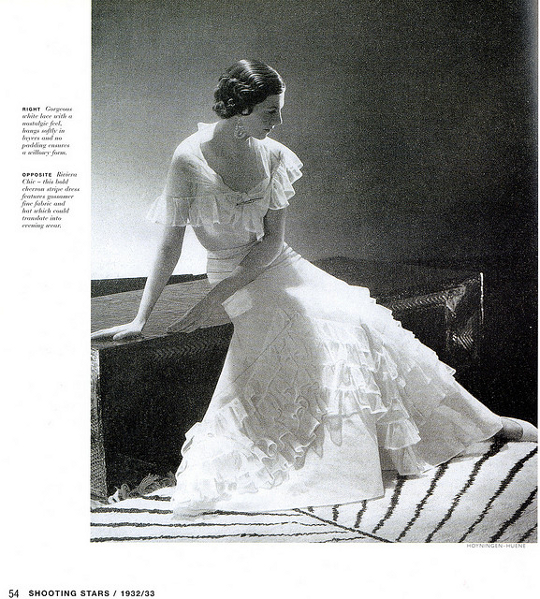
Source: Carbonated on Flickr
The glam of the ’30s was accentuated with tiered ruffles. Ruffles are made using extra material used to create volume and structure to a dress. The way a dress draped on the female form was a point of focus for many ’30s designers. Come ’40s fashion, ruffles would disappear from a woman’s dress since they required extraneous material and because of wartime rations, was shunned as a style element of 1940s clothing.
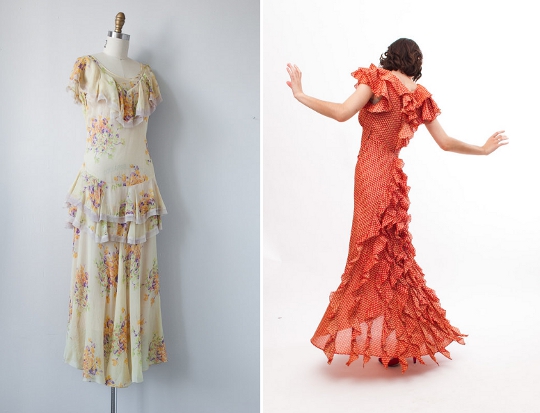
Buy It Vintage: 1930s Ruffled Garden Party Dress, $228 / 1930s Red Pentagon Print Party Dress, $598
Why It’s Fabulous: Because the tiered volume of ruffles on a girls’ frame is the surest way to feel like a fairy tale princess, but without having to wear layers of movement-restricting crinoline below a hoop skirt like a modern day Cinderella.
1930s Fashion Trend #3: High Cap Sleeves

Source: Etsy
High cap sleeves were an element of the romanticism that captivated 1930s fashion. ’30s designer Robert Piguet was a pioneer of the romantic trend, whose 1936 collection encapsulated this fairy tale fashion he based on 16 century clothing styles. This style of sleeve (I call it the “puff” sleeve) was typically incorporated onto prairie-inspired party dresses with tiered skirts, square necklines plus bonus details like ribbons and bows, similar to that shown in the ’30s sewing pattern above. “Flutter” sleeves were also popular in the ’30s, essentially a pleated sleeve that looks a bit like a small bird’s wing. It was a style of sleeve often imitated in “1970s does 1930s” fashions.
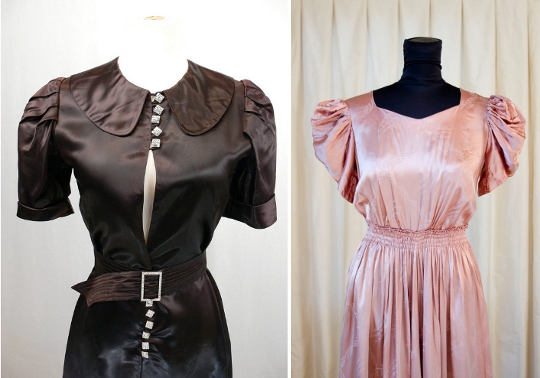
Buy It Vintage: 1930s Black Satin Puff Sleeve Beauty, $288/ 1930s Pink Puff Sleeve Party Dress, $185
Why It’s Fabulous: Because high cap sleeves are a fashion risk for many so if you can pull it off, then you’re absolutely nothing short of fabulous.
My suggestion? Wear the more voluminous style of the cap sleeve if you’re a tall lady with a slender neck, since a lot of attention is going to be up in those high parts of your frame.
Shoulder-length hair should also draw some of the attention away from your larger-than-life puff sleeves, or simply opt for smaller shape for a less theatrical trend.
1930s Fashion Trend #4: Lace Dresses
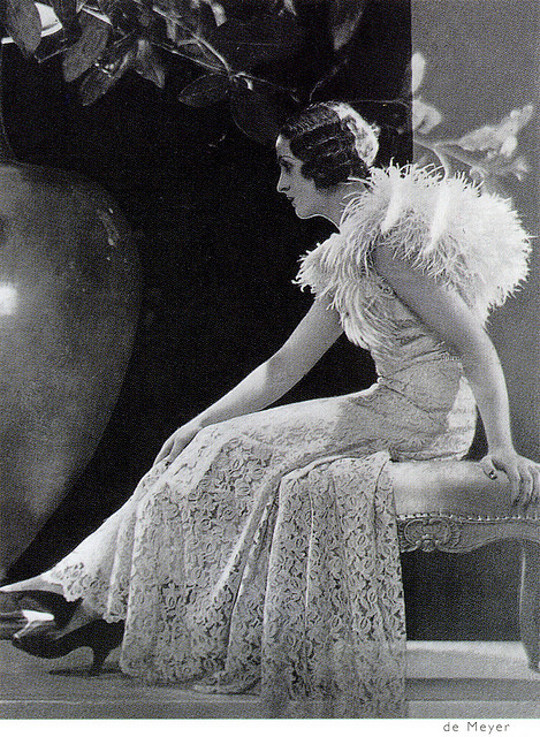
Source: Carbonated on Flickr
Floor-length lace dresses made a comeback to ’30s fashion because of the era’s love affair with feminine romanticism and rejection of the girl-does-boy-style flapper craze of 1920s clothing. Without a doubt, wearing an all-lace dress was a sign of luxury and upper class social status, especially considering the Great Depression was raging and materials like rayon and recycled “feedsack” dresses (literally the material from bags of feed for farm animals) were worn by the masses. The all-lace look was one reserved for evening affairs, however, as social changes increased women’s daily duties outside of the home and the expectations of dressing luxuriously before 5PM relaxed.
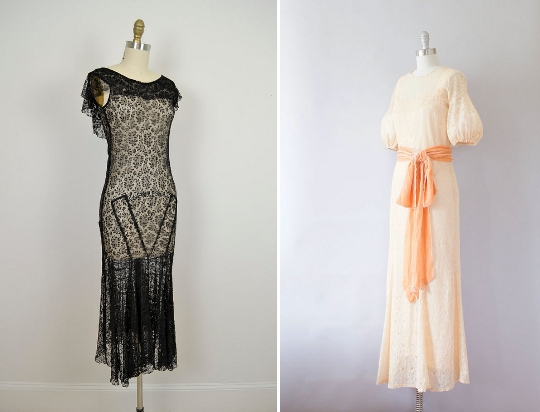
Buy It Vintage: 1930s Midnight Cordelian Lace Dress, $285 / 1930s Peach Sorbet Lace Dress, $172
Why It’s Fabulous: Because a lady in lace is a lady who feels loved! The luxurious touch of (real) lace is not one many girls experience before their wedding days (or perhaps the bedroom, first!) I own three gorgeous lace dresses that resemble the black Cordelian above. Unfortunately each has seen its final vintage wear, as the silk has “dead rot” meaning the fibers have lost strength over time and so with wear in today’s modern world, would ultimately tear to shreds.
1930s Fashion Trend #5: Capes & Cloaks
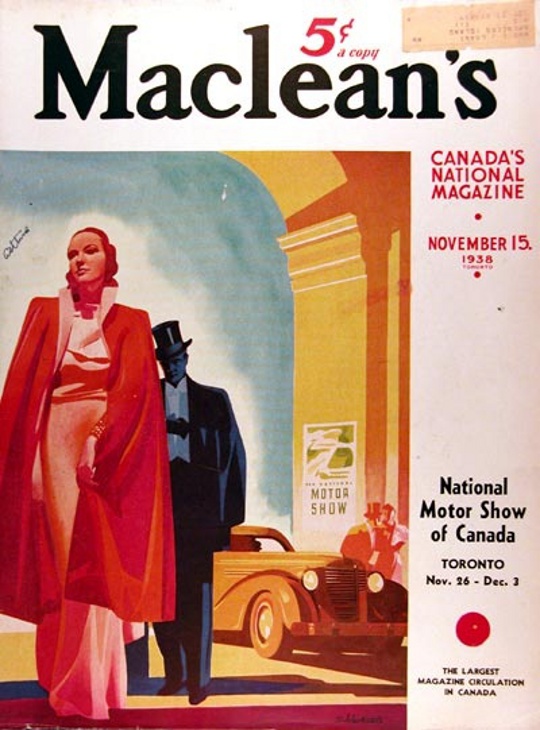
Source: Ad Classix
Capes and cloaks were a part of the mysterious, almost mystical glamour evoked by 1930s fashion. It was a return to the Victorian era of wearing a cape or cloak as both fashionable and practical protection from the elements.
This outerwear trend was particularly helpful for evening wear styles. Women wore them over their dresses so as not to cover too much of their glory — but most times the cape alone was glorious enough to look at!
These magical mistresses of the cape, cloak and caplet styles weren’t wearing a style all that very new in the ’30s. In fact, every man and woman owned a cloak in the 16th century for outerwear utilitarian function.
It was the Victorians who adopted shorter styles of the cloak known as “capes” if not wearing what we know today as a proper coat, then called redingotes (source: Fashion-Era.com).
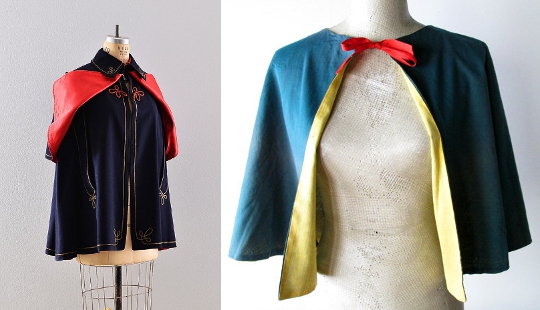
Buy It Vintage: 1930s Marching Band Style Navy/Red Cape, $365 / 1930s Green & Yellow Capelet, $38
Why It’s Fabulous: Because while you could simply wear a peacoat, leather jacket or heavy sweater when the temperature dips, you’re instead wearing an alluring garment that definitely not every girl owns. Caped ‘n chic, is what I say!
1930s Fashion Trend #6: Silk Dresses
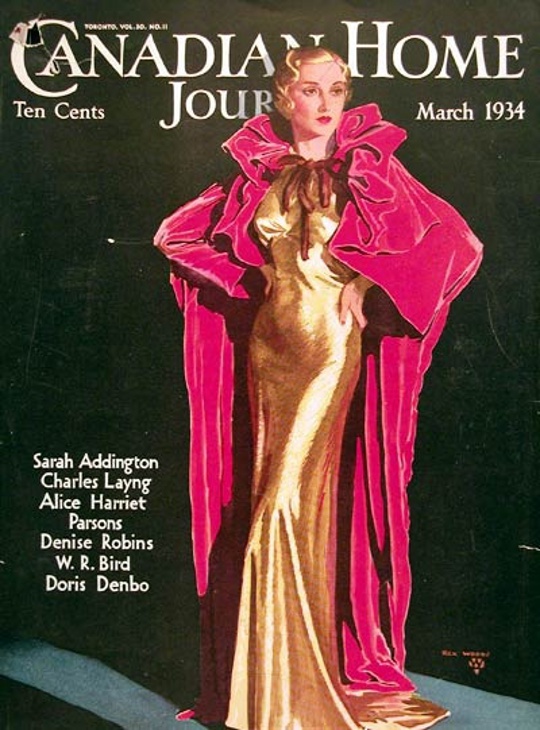
Source: Ad Classix
Silk was sexy and sensational in the ’30s. In 10 years time silk would literally be banned from use in clothing, since it was the necessary fabric to make parachutes for soldiers during World War II. But the ’30s was pre-war and silk was pretty popular with the ladies, especially thanks to the bias cut method (which helps silk to gracefully skim the body) invented by Madeleine Vionnet in the 1920s and popularized by ’30s era designers like Madame Gres.

Buy It Vintage: 1930s Bias Cut “Harlow” Gown, $385 / 1930s Silk Dressing Gown, $265
Why It’s Fabulous: Because wearing a silk dress is like wearing a piece of lingerie wherever you are going. The material skims the surface of your skin just so, as if with one false move you’ll expose a little too much of what lies below.
And if that isn’t sexy, I don’t know what is!
Editor’s Note: Expert insights were provided by Wearing History in the comments of this post. See below!
1930s Fashion Trend #7: Metal Zipper

Source: The Vintage Traveler
We have Elsa Schiaparelli to thank for the introduction of the zipper to fashion in the ’30s. While it was invented in 1893, the zipper was used rarely in clothing because it was seen as worn by promiscuous woman. Reason being that since a lady could remove her clothing so quickly with a zipper, that she must have been sleeping around to want such a removal device on her clothing at all! Being the daring designer that she was, Schiaparelli changed all of that when she began using the zipper as a decorative accent to her garments, putting the “metal teeth trend” on the fashion map.

Buy It Vintage: 1930s Dressing Gown, $275
Why It’s Fabulous: Because wearing a zipper for pure decoration is true homage to one of fashion’s most illustrious designers and considering its history, a small display of fashion feminism. The ’30s dressing gown shown above is a great example of how a zipper was treated to the front of the garment for all to see — judgement free!
1930s Fashion Trend #8: Crepe Dresses

Source: Advertising is Good for You
Crepe — a material made from silk that has a crisp or somethings crimpy texture — was a more popular material in the first half of the ’30s. Crepe is a thicker material than purely woven silk and lacks its luster, appearing more as a matte coloring. Crepe dresses were perfect for 1930s daywear that was still regarded as high-fashion and luxurious.
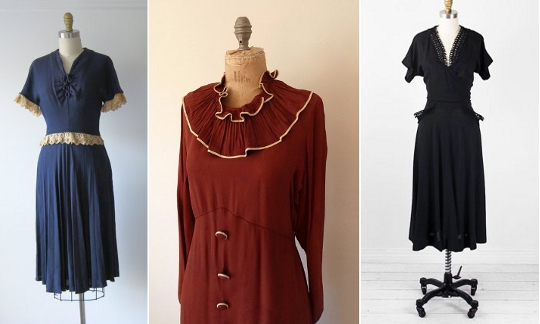
Buy It Vintage: 1930s “Miss Hollywood” Navy Crepe Dress, $125 / 1930s Rust Collared Crepe Dress, $52 / 1930s Black Crepe Evening Dress, $136
Why It’s Fabulous: Because this style of material is nearly impossible to find in stores at these prices when made from silk. You can buy crepe polyester blends, but even then you’re going to be far pressed to find a garment as lovely and affordable as the three you see listed above.
1930s Fashion Trend #9: Shocking Pink Color
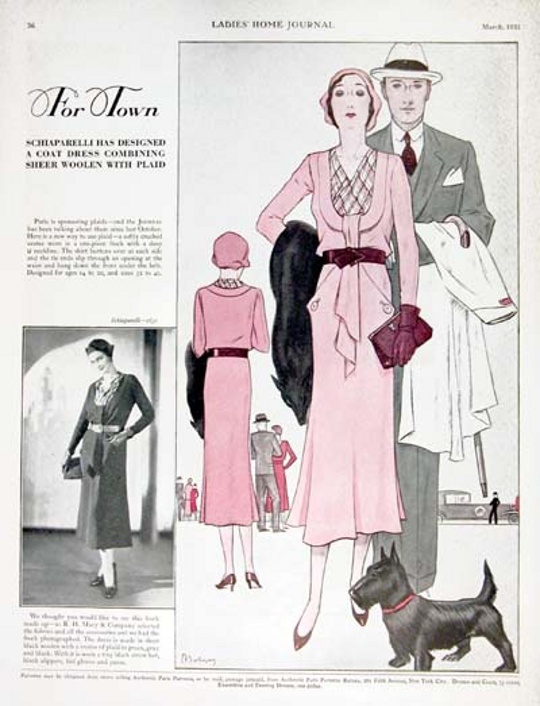
Source: Ad Classix
Oh Elsa Schiaparelli, you did it again! She quite literally invented the color “shocking” pink, which had never been integrated into the palette of fashion before. Schiaparelli used the color, which she said was “life-giving, like all the light and the birds and the fish in the world put together, a color of China and Peru but not of the West,” according to Lisa’s History Room. as the color of the box of her perfume released in 1936, appropriately called “shocking.” Today we call Elsa Schiaparelli’s shocking pink hot pink — like something a Barbie doll would wear. But because it was so new to the eyes of a ’30s lady, the more appropriate term was one to warn the wearer what she was about to see!
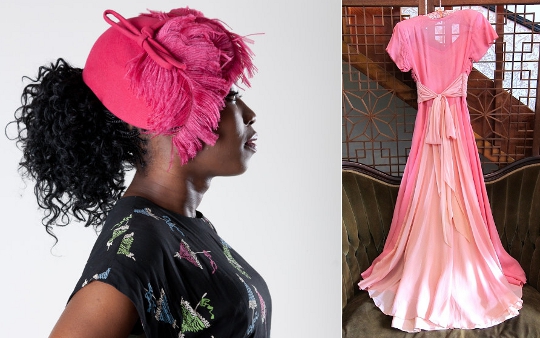
Buy It Vintage: 1930s Pink Feather Hat, $125 / 1930s Shocking Pink Chiffon Gown, $95
Why It’s Fabulous: Because not only does Barbie wear it but Miss Piggy loves it, and because chances are that you loved it as a little girl (I’m a sucker for fashion memories).
When worn right, you make a statement that’s not just shocking, but sensational.
Editors note – Expert insights were provided by Adeline’s Attic Vintage in the comments of this post. See below!
1930s Fashion Trend #10: Halter Dresses
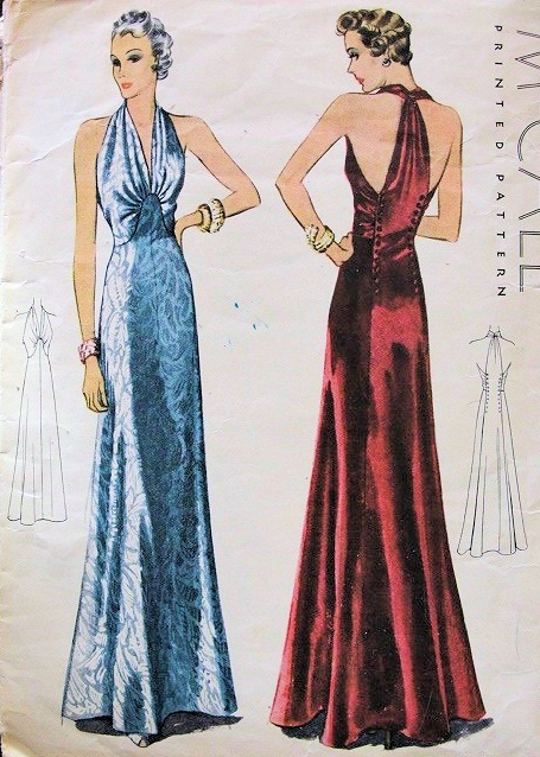
Source: Vintage Patterns
The halter dress was a hot commodity in ’30s fashion because like the era’s popular backless dress styles, it exposed the new “sensual” zone of a lady’s body: Her shoulder blades and backside. The style was made popular by the designs of Madeleine Vionnet, who was also the inventor of the bias cut method.

Buy It Vintage: 1930s Burgundy Halter Dress, $315
Why It’s Fabulous: Because we often forget how amazing designers are of the past and how they popularized the styles we are wearing today. While you may think nothing of the halter’s origins, if it weren’t for the ’30s (and its proponent, designer Madeleine Vionnet) you wouldn’t be wearing those cute halter sun dresses from H&M today.
1930s Fashion Trend #11: Bias Cut Dresses
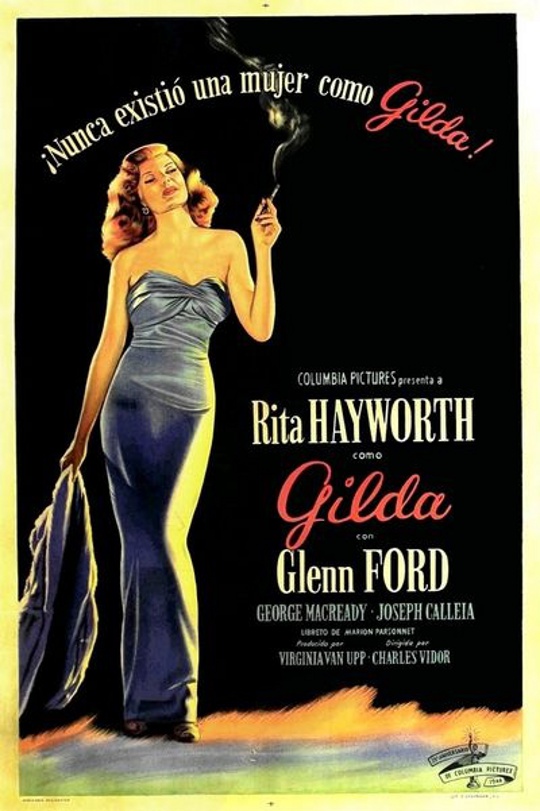
Source: Found in Mom’s Basement
Speaking of Madeleine Vionnet (as mentioned in trend #10), we also have her to thank for the invention of perhaps the sexiest way to wear a silk dress: The bias cut method. A phenomenal feat for a woman of her day, she invented the method in the ’20s and upon introduction it created quite the positive stir in fashion. Described by Wikipedia to be “a technique for cutting cloth diagonal to the grain of the fabric enabling it to cling to the body while moving with the wearer,” the bias cut method was the ultimate sex appeal for a silk dress to literally cling to the frame of a lovely lady. That’s why when you see such gorgeous ladies Rita Hayworth on ’30s movie posters, they’re wearing a bias cut dress!
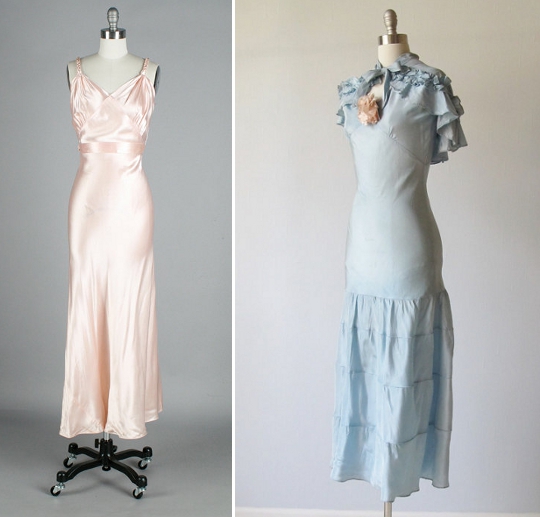
Buy It Vintage: 1930s Pink Silk Satin Dress, $415 / 1930s Bias Cut Dress with Capelet, $158
Why It’s Fabulous: Because you’re honoring the accomplishment of a pioneering female for her revolutionary invention that rather than hide the natural goodness of a lady’s frame with a definitive silhouette, allowed a girls’ bod to just be simply beautiful.
1930s Fashion Trend #12: Knitwear
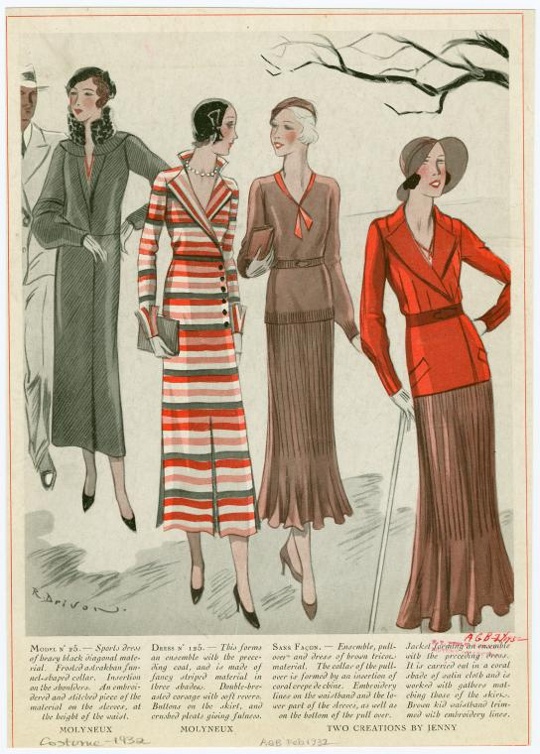
Source: Found in Mom’s Basement
Rival to fashion artist Elsa Schiaparelli, Coco Chanel was more of the practical designer for the ’30s era, releasing collections which catered to an upscale clientele with more conservative tastes. Because she was so trusted in the fashion world, when she began using jersey knit in women’s suiting as early as 1916, the fashion media and its followers took attention. It would take another decade for the knitwear trend to be embraced by the upscale woman, but because the ’30s era allowed women to be more flexible in their daywear fashions the knit suit became a big trend thanks to comfort and ease of movement.
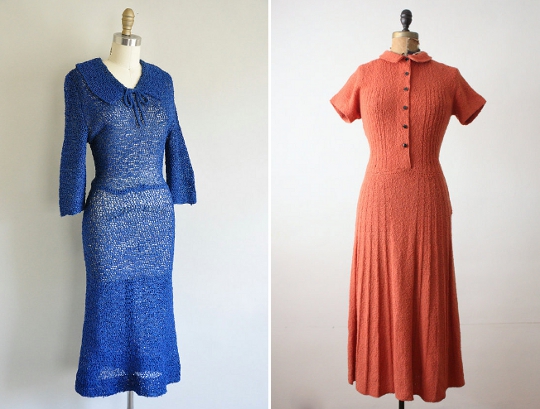
Buy It Vintage: 1930s “Blue Eyed Jane” Navy Knit Dress, $165 / 1930s Coral Knit Dress, $219
Why It’s Fabulous: Because knit dresses and knit suits are quintessential chic without looking drab (and having to wear say, a corporate-looking wool suit). The ’30s knitwear trend embraced knit for its solid colors, but ’70s knitwear a la Missoni mesmerized us with brilliant prints and psychedelic motifs.
1930s Fashion Trend #13: Oxford Shoes
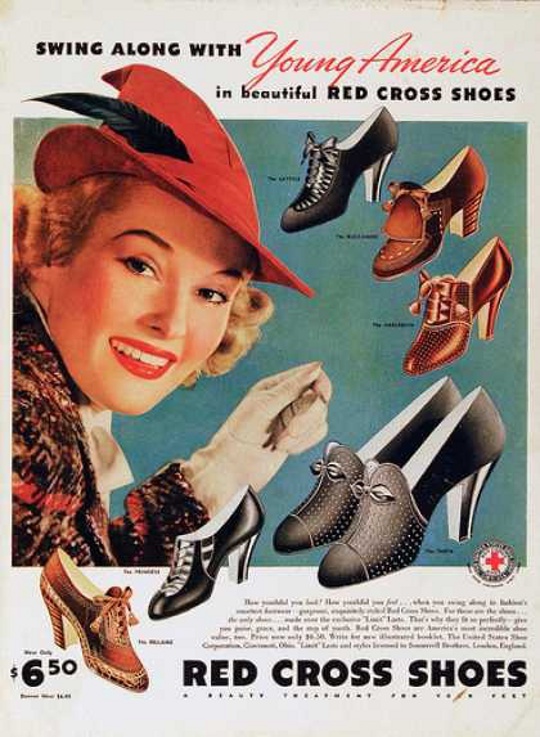
Source: Vintage Ad Browser
Shoe trends didn’t change much between the 1920s and 1930s. A consistent trend between the eras were lace-up style leather oxfords with chunky heels and a round toe. This style of shoe was fitting for the knit suits and crepe dresses that were worn by women from morning to early evening. Since a day dress was shorter than a floor-length one for evening, ’30s style oxfords were designed with taller heels and according to Vintage Dancer’s guide to 1930s and 1920s shoes, were more colorful and decorative than similar versions from previous eras.
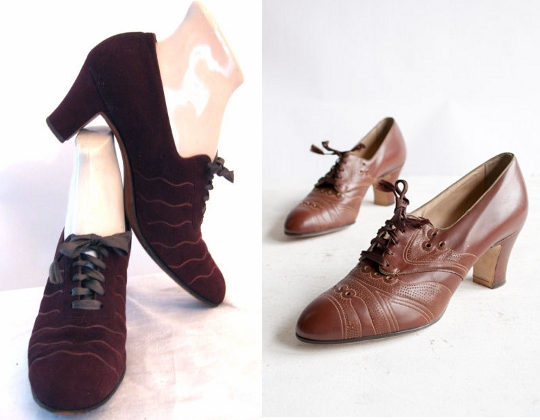
Buy It Vintage: 1930s Suede Laced Oxfords, $55 / 1930s Laced Deco Oxfords, $115
Why It’s Fabulous: Because the heeled oxford is perhaps the most utilitarian and sexy form of a heel a girl can own. Plus, in vintage leather and suede versions it looks like you’re wearing a pair of Italian made shoes of top notch craftsmanship and quality. Take that, expensive Frye boots!
1930s Fashion Trend #14: Unique Hats
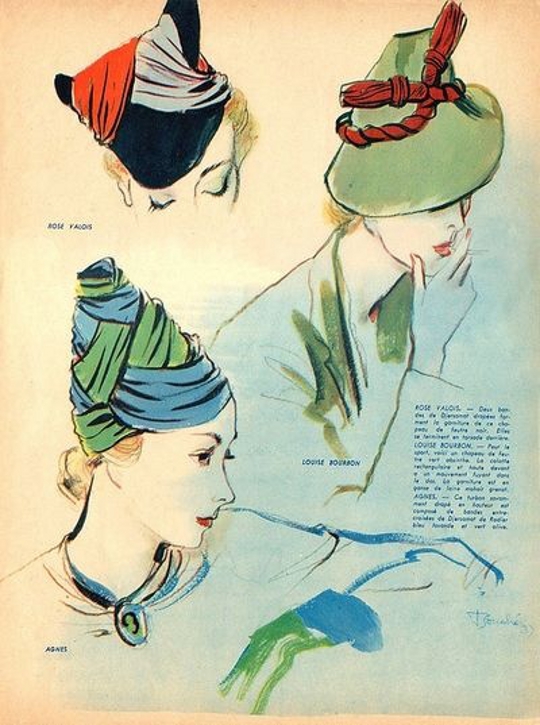
Source: Found in Mom’s Basement
Not that expressionist hats were a new thing for the ’30s, but the trends of the decade did call for more attention-grabbing styles, especially as popularized by the strange and surreal hat styles of designer Elsa Schiaparelli (she made ice cream cone and shoe hats!). Trendy ’30s hats were smaller in size than predecessors of previous eras (how can we forget the humongous headgear of the Edwardian period!) and were worn at a tilt on the head, often with a geometric flavor to their designs so that they looked like cones, squares, triangles, diamonds and other 3-D shapes.
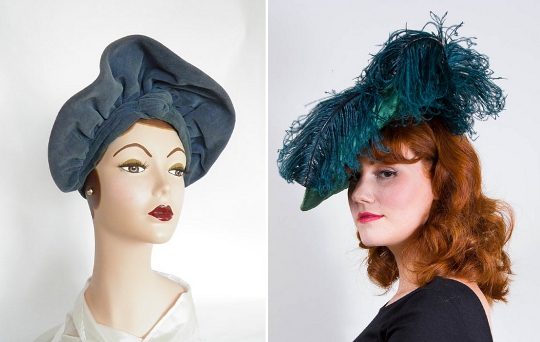
Buy It Vintage: 1930s Halo Hat, $60 / 1930s Feathered Tilt Hat, $148
Why It’s Fabulous: Because if you can successfully style an outfit wearing a hat like one of these, you rival even the hippest of church ladies rocking their holiest of headgear every Sunday morning!
1930s Fashion Trend #15: Costume Jewelry
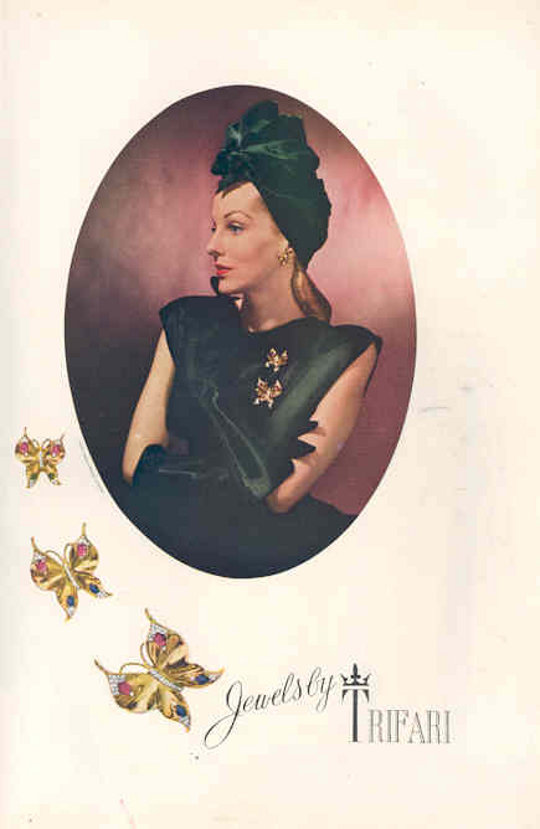
Source: Morning Glory Jewelry
The economic strains of the Great Depression motivated the purchase and wear of costume jewelry to jazz up last season’s outfits that with more income in pocket, would normally have been replaced by high society ladies. Costume jewelry was called as such because it was cheaply made and intended to be worn only for the season with one or two outfits. Coco Chanel popularized costume jewelry when she promoted the inclusion of it with the garments in her collections, therefore “completing the costume” with these faux jewels.
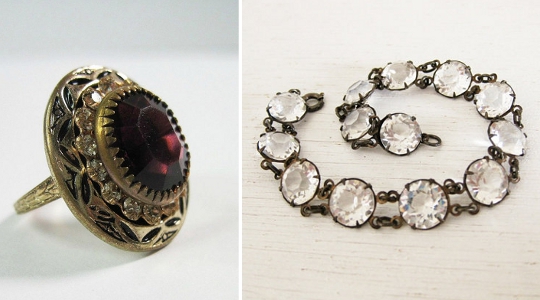
Buy It Vintage: 1930s Art Deco Ring, $64 / 1930s Crystal Bracelet, $66
Why It’s Fabulous: Because costume jewelry back then is far from what I’d consider costume jewelry today (hello, cheap and crappy Claire’s). Plus, if you have a really nice grandmother who lived during the ’50s (the second renaissance of costume jewelry) you can request a look at her collection for some finds she just may pass on to you.
More 1930s Fashion
Influence: Five 1930s Fashion Trends That Rocked the Boat
How to Dress in ’30s Fashion from Blue Velvet Vintage
Why 1930s Fashion Was Spellbinding from Frock ‘n Fabulous
1930s Vintage Movie Stars Who Inspired the Trends from Movie Maidens
1930s Fashion Explained by Head Over Heels Shop
1930s Fashion Reproduced Styles by ModCloth
1930s Fashion Family Photographs from Your Vintage Life

The remarkable thing about the ’30s, in my honest opinion, was its emphasis on luxury despite the economic hardships. Will future fashion historians say the same about American fashion 2008 onward? I can only wonder!
another fabulous post thankyou!
love all the info as well as the photos and the art deco ring is to die for!
Vintage babe! yes you are a babe! That ring *is* amazing. I want to wear 5 on one hand. ha!
What a fabulous blog! Vintage jewelry is my passion. My second passion is watching old films. From the silents through the 50s. I love to see what the actors are wearing. It can really give you some great insight on jewelry and fashions of the times. Wearing a piece of vintage jewelry or clothing that was made 50 to 100 or more years ago, makes a unique statement. It is also a testament to how well these pieces were made. They have stood the test of time. Sammy, thanks so much for including my 1930s vintage ring in your article!
Wicked Darling I am inspired by your love of vintage cinema — it is, as you say, truly how we can know the styles of the day! I am guilty as charged for not watching as much as I should. Can you believe it has been years since I saw Gone with the Wind?! As for sharing your ring, my pleasure. Thank you for spreading 1930s fashion love.
Hi Sammy,
I’m most grateful for the feature of the 1930s bracelet from my little etsy shop! and ofcourse you have a wonderful blog and will connect with you via media outlets as well. Thanks again.
Fabiola @ HuellaHuella on etsy.
xox
Hi FAB! Love the name! Of course, it is my pleasure to feature your bracelet. Thank you so much for allowing me to do so. Keep on spreading that 1930s fashion love. xx
Another great blog post, Sammy! I always feel smarter after I read one of your articles!
Thank you for the inclusion of my 30s clamshell brim hat!
Cindy, thank you! And for inspiring old fashioned research and reading real books ;-)
Great piece on 1930s fashion and happy to be included! Here’s a post I put together on 30s icons, trends and styles some time ago as a guest blogger for birchbox.com. An addendum to an awesome write up – http://blog.birchbox.com/post/15590995115/channel-20s-and-30s-hollywood-glamour-guest-blogger
I just read this, and I had no idea “Joy” was the best selling perfume of the era. These are amazing vignettes of ’30s fashion … from the broadtail fur stoles (I’ve always wanted one) to notes on carrying compacts to apply makeup in person. Thank you!
Nice feature on one of my favorite eras in fashion. It’s nearly impossible to not be seduced by the fabrics, prints, and unique construction of 30s garments. Thank you for including my lace dress!
Heather thank you so much for taking the time to stop by the site and leave a comment! I hope the ’30s has a revival in fashion soon. Let’s cross our fingers!
This post is DELICIOUS Sammy! A dear friend purchased the blue 1930s dress with caplet at the “Endless Yard Sale” or also know as “127 Corridor Sale” I always envisioned a young lady wearing it, maybe 16 or so. It’s such a sweetly styled dress.
this was a great blog! Thank you!
thanks #vintagelover!
certainly like your web-site but you have to check the spelling on several of your posts. Many of them are rife with spelling problems and I to find it very troublesome to tell the truth nevertheless I’ll certainly come again again.
Nice and lovely article and it leads to so many other wonderful places to enjoy. Miss Hayworth wore the 30’s look well in 1946.
You can certainly see your enthusiasm in the article you write.
The arena hopes for more passionate writers like you who are
not afraid to say how they believe. Always follow your heart.